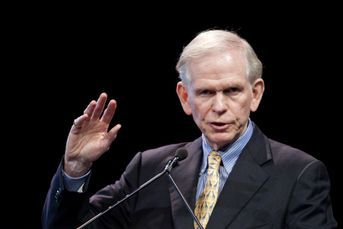Gross charts own path with bonds that rivals shun
Bond king bets on five-year Treasuries that other money managers say will suffer when Fed raises rates.
As Bill Gross vows to restore top performance at the world’s biggest bond fund, he’s taking a path many of his rivals shun.
Mr. Gross, who manages the $230 billion Pimco Total Return Fund (PTTRX) at Pacific Investment Management Co., is betting that five-year Treasuries, which are more sensitive to changes in the central bank rate than longer-dated bonds, will do well because markets overestimate how much the Federal Reserve will raise interest rates. Bond managers at the Goldman Sachs Group Inc., BlackRock Inc. and JPMorgan Chase & Co. argue that he’s wrong and the intermediate bonds he holds will suffer when the Fed lifts borrowing costs.
“Once they see the whites of the eyes of full employment, they will want to normalize rates at a faster clip,” said Jonathan Beinner, co-head of global fixed income at Goldman Sachs Asset Management.
Mr. Gross is betting on an economic view he calls the “new neutral,” which argues that the top speeds of the biggest economies and their equilibrium interest rates have declined and won’t return to levels seen before the financial crisis. While most bond managers agree rates will be lower, with the federal funds target ranging somewhere between 3% and 4% by 2018, Mr. Gross sees it at just 2%, making bonds attractive to Pimco that BlackRock and Goldman Sachs won’t touch.
(See also: The bear market in bonds has not been seen and here’s why)
‘BELIEVE ME’
As of April 30, his Pimco Total Return Fund had 94% of its money in bonds with maturities of 10 years and less, with the biggest concentration, 38%, in bonds with maturities of three to five years, according to the firm’s website, Mr. Gross was betting against bonds with maturities of greater than 20 years.
If he’s right, the bond king could emerge triumphant and end his fund’s longest streak of redemptions. If he’s wrong, he could underperform peers for a third year in four.
“Believe me, by the end of 2014, Pimco’s going to be at the top, not close to the middle,” Mr. Gross said in a May 14 interview on Bloomberg Television. He said he’s buying bonds maturing in five years to seven years.
Pimco’s new forecast, published in a report May 13, is the product of its annual Secular Forum, which guides the firm’s world view and investment philosophy over the next three to five years. In the aftermath of the 2008 financial crisis, that forum used the term “new normal” to describe an era of subdued returns, heightened government intervention and increasing clout for emerging nations in the global economy.
The heart of Pimco’s “new neutral” message — that interest rates will not return to historically normal levels anytime soon — is broadly accepted. The predictions for the benchmark rate differ. Mr. Beinner said it could be 3.5% to 4% by 2018. His counterparts at BlackRock and JPMorgan contend that 3% is probably a better bet.
“Rates will be lower than they have in the past,” said Rick Rieder, chief investment officer for fundamental fixed income at BlackRock. Mr. Rieder, who oversees $700 billion, cited slower global growth, an aging population and subdued consumer spending as reasons to expect relatively low rates for an extended period.
Still, Mr. Rieder expects interest rates to rise as the U.S. economy grows “at a pretty steady 3%,” barring problems in the housing market.
DIFFERENT CHOICES
Robert Michele, who oversees $370 billion as head of fixed income at JPMorgan Asset Management, is looking for U.S. growth in the 3% to 3.5% range over the next few years. An expansion of that pace, combined with some pickup in inflation, would allow the Fed to push up rates gradually to about 3%.
The distinctions are big enough to drive very different investment choices. Mr. Gross argues that intermediate-term bonds reflect market expectations for Fed rates of as much as 4%, meaning they will do well once markets realize that the central bank has limited room to increase borrowing costs. Longer-dated bonds offer less value after rallying the most this year, he said.
Treasuries maturing in five years have returned 2.05% this year through May 27, compared with gains of 5.9% for 10-year notes and 13% for 30-year bonds, Bank of America Merrill Lynch Index data show. Five-year note yields have dropped to 1.48% from 1.74% and 10-year yields are down to 2.44% from 3.03%. Yields on 30-year bonds dropped to 3.29% from 3.97% at the end of 2013.
Most of the other bond managers say they like the 20- and 30-year bonds that Mr. Gross is avoiding, while steering clear of the intermediate bonds he recommends. They say that as the Fed starts to raise rates, short and intermediate rates will feel the brunt, while long-term rates will rise less.
“We do NOT like the five-year U.S. Treasury,” John Bellows, a money manager at Western Asset Management Co., wrote in an e-mail. Western Asset, a division of Legg Mason Inc., manages $469 billion in bonds.
“Holders of those maturities have become complacent about the potential for rising rates,” Mr. Michele said. Longer-dated bonds in the 20-year to 30-year range are more attractive, he said, because pension funds, looking to avoid risk, are boosting demand for the securities.
‘SOME SENSE’
Mr. Rieder said he’s avoiding the “belly of the curve,” bonds with maturities of three to seven years, and agreed that “long Treasuries make some sense,” because of demand from institutional investors. Mr. Beinner said he is steering clear of bonds in the three- to five-year range because they will be hurt in the tightening cycle.
Mr. Beinner, who oversees $411 billion in fixed-income investments, also is counting on a stronger U.S. economy, driven by improvements in housing and corporate spending. The U.S. expanded 1.9% in 2013, according to data compiled by Bloomberg.
“We are not going to have a boom, but we should do better than the anemic 2% growth levels we have seen,” he said.
There are bond managers more in sync with the “new neutral.” Franco Castagliuolo, who helps oversee $34 billion in government and mortgage bonds at Fidelity Investments, expects rates to rise very slowly.
“High rates would be too painful for the recovery,” he said. Mr. Castagliuolo prefers 5-year bonds to 30-year bonds, arguing that yields on the longer-dated securities don’t reflect economic fundamentals.
Pimco, in its second-quarter market outlook, predicted that the economy would expand in the 2.5% to 3% range. In its secular outlook, the firm wrote that prospects for U.S. growth over the next three to five years “encompass a wider range of optimistic outcomes than do prospects for other major economies, though growth at pre-crisis trends is unlikely for years to come.”
With the Fed boosting rates slowly, intermediate bonds will be “anchored” by the central bank, said Scott Mather, deputy chief investment officer at Pimco. Because the Fed has less influence over longer-dated bonds, their future yields are more uncertain, he said.
“For taking on that extra risk, you are not picking up much extra yield,” he said.
GROSS’ RECORD
Mr. Gross’s fund beat 95% of rivals over the past decade, according to Morningstar Inc., on the strength of his calls on the economy and interest rates. He outperformed 99% of peers in 2007 by being early to see the weakness in the housing market, according to data compiled by Bloomberg. He trailed 66% of similar funds in 2013 when the debt he held lost value after the Fed hinted it would begin to scale back its bond buying program.
Investors pulled a record $41.1 billion from Pimco Total Return last year and $11.3 billion in the first four months of 2014, according to Morningstar.
Mr. Gross, in the May 14 interview with Bloomberg, said his fund’s performance this year has improved as the bonds it favors gain ground. Pimco Total Return has beaten 96% of peers in the past month.
“Pimco will do well,” he said. “We have a thesis. We are sticking to our guns.”
(Bloomberg News)
Learn more about reprints and licensing for this article.








